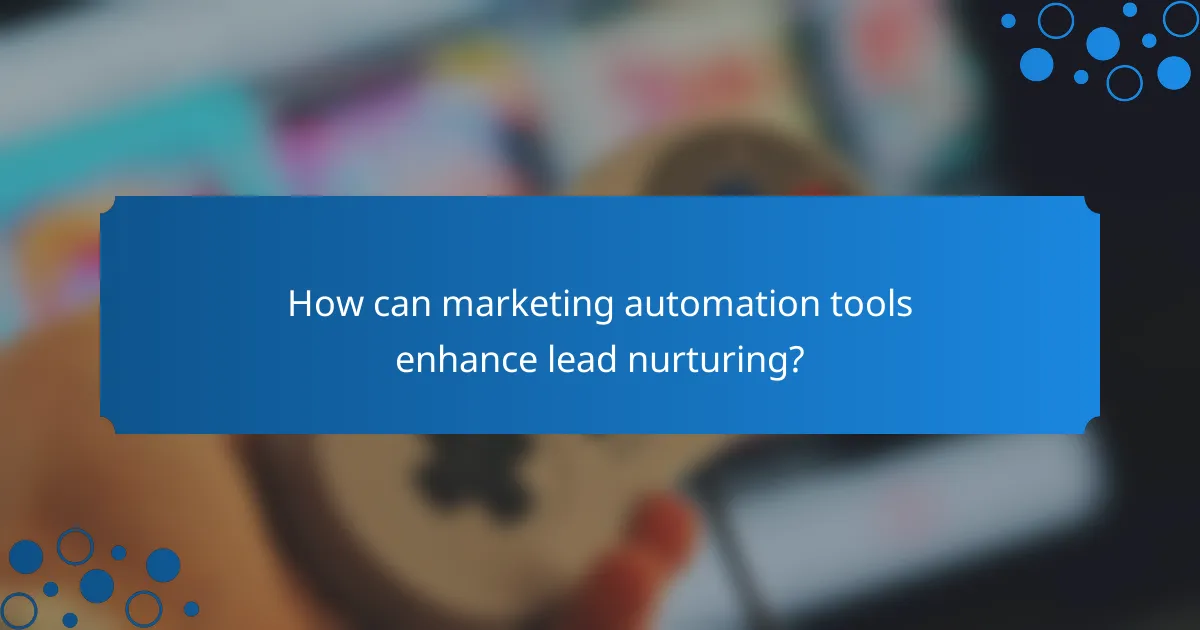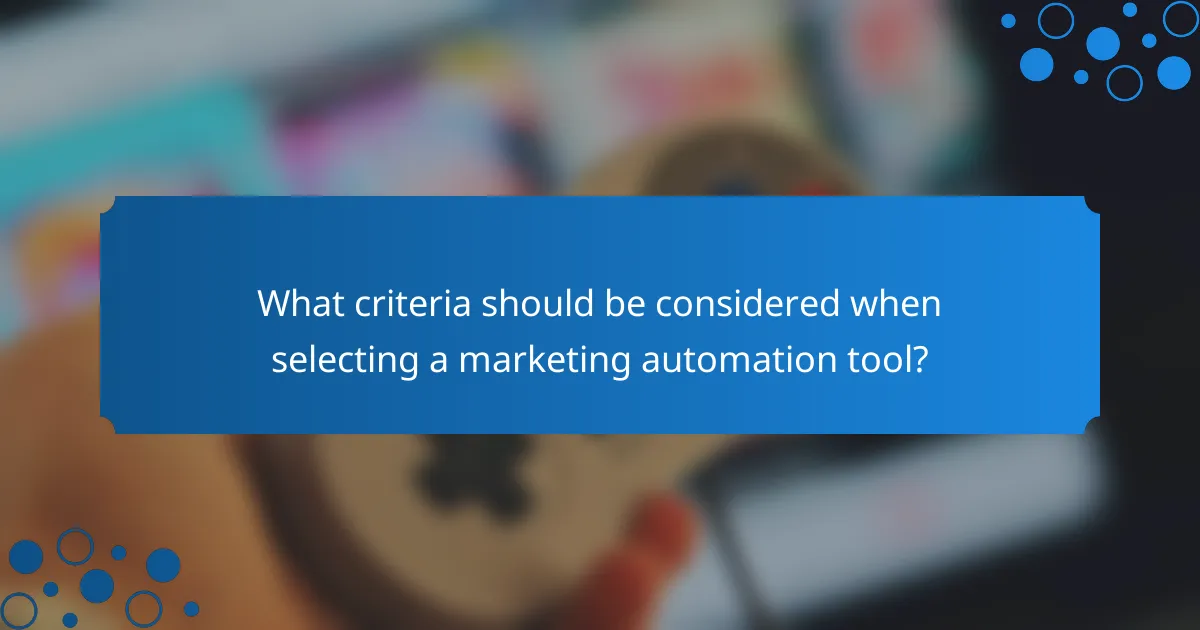Marketing automation tools play a crucial role in optimizing campaign management, enhancing lead nurturing, and providing valuable performance metrics. By automating repetitive tasks, these platforms allow marketers to concentrate on strategic initiatives and creative content. Additionally, they facilitate personalized communication with leads, ensuring timely and relevant interactions that guide prospects through the sales funnel.

What are the best marketing automation tools for campaign management in New Zealand?
The best marketing automation tools for campaign management in New Zealand include platforms that streamline processes, enhance lead nurturing, and provide insightful performance metrics. These tools help businesses automate repetitive tasks, allowing marketers to focus on strategy and creative aspects.
HubSpot Marketing Hub
HubSpot Marketing Hub is a comprehensive platform that integrates various marketing functions, including campaign management, email marketing, and analytics. It offers user-friendly tools for creating and managing campaigns, segmenting audiences, and tracking performance metrics.
With features like drag-and-drop email builders and customizable workflows, HubSpot allows marketers to nurture leads effectively. Pricing starts with a free tier, making it accessible for small businesses, while advanced features are available in paid plans that can range from a few hundred to several thousand NZD per month.
ActiveCampaign
ActiveCampaign focuses on email marketing and automation, providing robust tools for campaign management and lead nurturing. Its automation capabilities allow users to create complex workflows based on user behavior and engagement, ensuring personalized communication.
ActiveCampaign’s pricing is competitive, with plans starting at around 20 NZD per month for basic features, scaling up based on the number of contacts and additional functionalities. This makes it a suitable option for businesses of varying sizes looking to enhance their marketing efforts.
Marketo
Marketo is a powerful marketing automation tool designed for larger enterprises, offering advanced features for campaign management and lead nurturing. It excels in providing detailed analytics and performance metrics, allowing marketers to optimize their strategies effectively.
While Marketo’s pricing is generally higher, often starting in the low thousands of NZD per month, its extensive capabilities justify the investment for businesses that require sophisticated marketing solutions. Marketo is particularly beneficial for organizations looking to scale their marketing efforts and improve ROI through data-driven decisions.

How can marketing automation tools enhance lead nurturing?
Marketing automation tools enhance lead nurturing by streamlining communication and personalizing interactions with potential customers. These tools enable businesses to manage campaigns effectively, ensuring that leads receive timely and relevant information that guides them through the sales funnel.
Personalized email campaigns
Personalized email campaigns are a cornerstone of effective lead nurturing. By using data from customer interactions, businesses can tailor messages to specific segments, increasing engagement rates. For example, sending targeted offers based on previous purchases can significantly improve conversion rates.
To implement personalized campaigns, consider segmenting your audience based on demographics, behavior, or interests. This allows for more relevant content, which can lead to higher open and click-through rates. Tools like A/B testing can help refine your messaging for optimal results.
Automated follow-ups
Automated follow-ups ensure that no lead goes cold by sending timely reminders or additional information after initial contact. This can be particularly useful in nurturing leads who may need more time to make a decision. For instance, a follow-up email a few days after a webinar can encourage attendees to engage further.
When setting up automated follow-ups, create a sequence that aligns with the lead’s journey. Use triggers based on actions, such as downloading a resource or visiting a pricing page, to send relevant content. This keeps your brand top-of-mind and encourages ongoing interaction.
Lead scoring systems
Lead scoring systems help prioritize leads based on their engagement and likelihood to convert. By assigning scores based on interactions, such as email opens, website visits, and social media engagement, businesses can focus their efforts on the most promising prospects. This targeted approach can enhance the efficiency of your sales team.
To establish an effective lead scoring system, define criteria that reflect your ideal customer profile. Regularly review and adjust scoring rules based on performance metrics to ensure alignment with your business goals. This adaptability can lead to improved lead conversion rates over time.

What performance metrics should be tracked with marketing automation tools?
Tracking performance metrics is essential for evaluating the effectiveness of marketing automation tools. Key metrics such as conversion rates, customer acquisition cost, and return on investment provide insights into campaign success and areas for improvement.
Conversion rates
Conversion rates measure the percentage of leads that take a desired action, such as making a purchase or signing up for a newsletter. This metric is crucial for understanding how well your marketing automation efforts are driving results. Aim for conversion rates that fall within industry averages, which typically range from 1% to 5%, depending on the sector.
To improve conversion rates, focus on optimizing landing pages, personalizing content, and utilizing A/B testing. Regularly analyze which campaigns yield the highest conversions and adjust your strategies accordingly.
Customer acquisition cost
Customer acquisition cost (CAC) refers to the total cost associated with acquiring a new customer, including marketing and sales expenses. Understanding CAC helps businesses assess the efficiency of their marketing automation tools. A lower CAC indicates a more effective campaign, while a higher CAC may signal the need for strategy adjustments.
To calculate CAC, divide total marketing expenses by the number of new customers acquired during a specific period. Aim for a CAC that is sustainable relative to the lifetime value of a customer, typically keeping it below 30% of that value.
Return on investment
Return on investment (ROI) measures the profitability of your marketing automation efforts by comparing the revenue generated against the costs incurred. A positive ROI indicates that your campaigns are effective, while a negative ROI suggests the need for reevaluation. A common benchmark for ROI in marketing is to aim for at least a 5:1 ratio, meaning for every dollar spent, five dollars are generated in revenue.
To improve ROI, focus on refining your targeting, enhancing customer engagement, and leveraging data analytics to make informed decisions. Regularly review your campaigns to identify which strategies yield the highest returns and allocate resources accordingly.

What criteria should be considered when selecting a marketing automation tool?
When selecting a marketing automation tool, consider integration capabilities, user interface, and overall functionality. These factors will significantly impact how effectively the tool can manage campaigns, nurture leads, and track performance metrics.
Integration capabilities
Integration capabilities refer to how well the marketing automation tool connects with other software systems, such as CRM platforms, email marketing services, and analytics tools. A tool that seamlessly integrates with existing systems can streamline workflows and enhance data sharing.
Look for tools that offer a wide range of integrations, including popular platforms like Salesforce, HubSpot, and Google Analytics. This ensures that your marketing efforts are cohesive and that data flows smoothly across your tech stack.
User interface and experience
The user interface and experience are crucial for ensuring that your team can effectively use the marketing automation tool. A clean, intuitive interface can reduce the learning curve and improve overall productivity.
Evaluate the tool’s dashboard, navigation, and ease of access to key features. Tools that offer customizable dashboards or drag-and-drop functionality can enhance user experience by allowing team members to tailor their workspace to their specific needs.

How do marketing automation tools integrate with CRM systems?
Marketing automation tools integrate with CRM systems to streamline customer data management and enhance marketing efforts. This integration allows for seamless data flow, enabling businesses to nurture leads effectively and track campaign performance.
Salesforce integration
Integrating marketing automation tools with Salesforce enhances lead management and campaign tracking. Users can automatically sync leads and customer interactions, ensuring that marketing teams have access to up-to-date information for personalized outreach.
Consider using Salesforce’s built-in automation features alongside your marketing tool to optimize workflows. For example, you can trigger specific marketing actions based on lead behavior tracked in Salesforce, improving engagement rates significantly.
Zoho CRM integration
Zoho CRM integration with marketing automation tools allows businesses to manage customer relationships and marketing campaigns from a unified platform. This integration facilitates lead nurturing by automating follow-ups and segmenting audiences based on their interactions.
When integrating with Zoho, ensure that you customize your workflows to reflect your sales processes. Utilize Zoho’s reporting features to analyze campaign performance and adjust strategies accordingly, which can lead to better conversion rates over time.

What are the emerging trends in marketing automation for 2024?
In 2024, marketing automation is increasingly focused on personalization, AI integration, and enhanced analytics. These trends aim to improve campaign management, lead nurturing, and performance metrics, allowing businesses to engage customers more effectively and efficiently.
Personalization in Campaign Management
Personalization is becoming essential in campaign management, as consumers expect tailored experiences. Marketers can leverage data analytics to segment audiences based on behavior, preferences, and demographics, enabling targeted messaging that resonates with specific groups.
For example, using dynamic content in emails allows businesses to customize offers and recommendations based on individual user data. This approach can significantly increase engagement rates and conversion, making personalization a critical strategy for 2024.
AI Integration for Lead Nurturing
Artificial intelligence is transforming lead nurturing by automating responses and predicting customer behavior. AI tools can analyze interactions and determine the best times to engage leads, ensuring timely follow-ups that enhance the likelihood of conversion.
Implementing chatbots for initial customer interactions is one practical application. These bots can provide instant responses to inquiries, qualify leads, and gather essential information, streamlining the nurturing process and improving overall efficiency.
Enhanced Performance Metrics
In 2024, businesses are focusing on enhanced performance metrics to measure the effectiveness of their marketing automation efforts. This includes tracking not only traditional metrics like open and click-through rates but also deeper insights such as customer lifetime value and engagement scores.
Utilizing advanced analytics tools can help marketers assess the impact of their campaigns more accurately. For instance, integrating multi-channel attribution models allows businesses to understand which channels contribute most to conversions, guiding future marketing investments.
